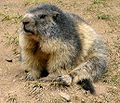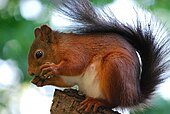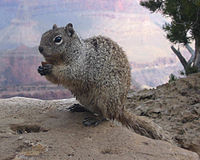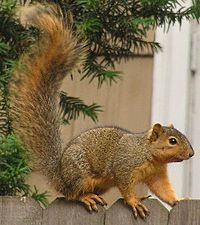Squirrel: Difference between revisions
Reverted good faith edits by 173.55.188.209 (talk): Not here. (TW★TW) |
No edit summary Tag: possible vandalism |
||
| Line 1: | Line 1: | ||
<gallery> |
|||
<gallery> |
|||
[[File:File:Example.jpg|Caption1 |
|||
File:Example.jpg|[[File:]]Caption2]][[File: |
|||
<gallery> |
|||
Squirrel.jpg |
|||
</gallery> |
|||
]] |
|||
</gallery> |
|||
</gallery> |
|||
{{About|the squirrel family (Sciuridae) as a whole}} |
{{About|the squirrel family (Sciuridae) as a whole}} |
||
<!-- High visibility page; likely move vandal target --> |
<!-- High visibility page; likely move vandal target --> |
||
| Line 61: | Line 71: | ||
Unlike [[rabbit]]s or [[deer]], squirrels cannot feed upon [[cellulose]] and must rely on foods rich in [[protein]], [[carbohydrates]], and [[fat]]. In temperate regions, early spring is the hardest time of year for squirrels, because buried nuts begin to sprout and are no longer available for the squirrel to eat, and new food sources have not become available yet. During these times squirrels rely heavily on the buds of trees. Squirrels' diet consists primarily of a wide variety of plant food, including [[nut (fruit)|nut]]s, [[seed]]s, [[conifer cone]]s, [[fruit]]s, [[fungus|fungi]] and green [[vegetation]]. However some squirrels also consume meat, especially when faced with hunger.<ref name="squirrels" /> Squirrels have been known to eat [[insect]]s, eggs, small [[bird]]s, young [[snake]]s and smaller [[rodent]]s. Indeed, some tropical species have shifted almost entirely to a diet of insects.<ref>Richard W. Thorington, Katie Ferrell - [http://books.google.com/books?id=Y7cuEWCWpLMC&pg=PA75&lpg=PA75&dq=some+tropical+squirrels+eat+almost+only+insects&source=bl&ots=8Mq7YGqzSL&sig=xszWl76FS4tJHB5oULDExUapN3A&hl=en&ei=BB4HTeuoCIep8AbG5_SFCg&sa=X&oi=book_result&ct=result&resnum=3&ved=0CCEQ6AEwAg#v=onepage&q&f=false ''Squirrels: the animal answer guide''], JHU Press, 2006, ISBN 0801884020, 9780801884023, p. 75.</ref> |
Unlike [[rabbit]]s or [[deer]], squirrels cannot feed upon [[cellulose]] and must rely on foods rich in [[protein]], [[carbohydrates]], and [[fat]]. In temperate regions, early spring is the hardest time of year for squirrels, because buried nuts begin to sprout and are no longer available for the squirrel to eat, and new food sources have not become available yet. During these times squirrels rely heavily on the buds of trees. Squirrels' diet consists primarily of a wide variety of plant food, including [[nut (fruit)|nut]]s, [[seed]]s, [[conifer cone]]s, [[fruit]]s, [[fungus|fungi]] and green [[vegetation]]. However some squirrels also consume meat, especially when faced with hunger.<ref name="squirrels" /> Squirrels have been known to eat [[insect]]s, eggs, small [[bird]]s, young [[snake]]s and smaller [[rodent]]s. Indeed, some tropical species have shifted almost entirely to a diet of insects.<ref>Richard W. Thorington, Katie Ferrell - [http://books.google.com/books?id=Y7cuEWCWpLMC&pg=PA75&lpg=PA75&dq=some+tropical+squirrels+eat+almost+only+insects&source=bl&ots=8Mq7YGqzSL&sig=xszWl76FS4tJHB5oULDExUapN3A&hl=en&ei=BB4HTeuoCIep8AbG5_SFCg&sa=X&oi=book_result&ct=result&resnum=3&ved=0CCEQ6AEwAg#v=onepage&q&f=false ''Squirrels: the animal answer guide''], JHU Press, 2006, ISBN 0801884020, 9780801884023, p. 75.</ref> |
||
Predatory behavior by various species of ground squirrels, particularly the [[thirteen-lined ground squirrel]], has been noted.<ref>{{cite journal | last=Friggens | first=M. | coauthors= | title=Carnivory on Desert Cottontails by Texas Antelope Ground Squirrels | jstor=3672818 | journal=The Southwestern Naturalist | volume=47 | issue=1 | pages=132–133 | year=2002 | doi=10.2307/3672818}}</ref> For example, Bailey, a scientist in the 1920s, observed a thirteen-lined ground squirrel preying upon a young chicken.<ref>{{cite journal | last=Bailey | first=B. | title=Meat-eating propensities of some rodents of Minnesota | journal=Journal of Mammalogy | volume=4 | issue= | page=129 | month= | year=1923 | url=}}</ref> Wistrand reported seeing this same species eating a freshly killed snake.<ref>{{cite journal | last=Wistrand | first=E.H. | coauthors= | title=Predation on a Snake by ''Spermophilus tridecemlineatus'' | jstor=2424389 | journal=American Midland Naturalist | volume=88 | issue=2 | pages=511–512 | year=1972 | doi=10.2307/2424389}}</ref> Whitaker examined the stomachs of 139 thirteen-lined ground squirrels, and found bird flesh in four of the specimens and the remains of a short-tailed [[shrew]] in one;<ref>{{cite journal | last=Whitaker | first=J.O. | title=Food and external parasites of ''Spermophilus tridecemlineatus'' in Vigo County, Indiana | jstor=1379067 | journal=Journal of Mammalogy | volume=53 | issue=3 | pages=644–648 | year=1972 | doi=10.2307/1379067}}</ref> Bradley, examining [[white-tailed antelope squirrel]]s' stomachs, found at least 10% of his 609 specimens' stomachs contained some type of vertebrate, mostly [[lizard]]s and rodents.<ref>{{cite journal | last=Bradley | first=W. G. | coauthors= | title=Food habits of the antelope ground squirrel in southern Nevada | jstor=1377723 | journal=Journal of Mammalogy | volume=49 | issue=1 | pages=14–21 | doi=10.2307/1377723 | year=1968}}</ref> Morgart (1985) observed a white-tailed antelope squirrel capturing and eating a [[Perognathus flavus|silky pocket mouse]].<ref>{{cite journal | last=Morgart | first=J. R. | coauthors= | title=Carnivorous behavior by a white-tailed antelope ground squirrel ''Ammospermophilus leucurus'' | jstor=3670745 | journal=The Southwestern Naturalist | volume=30 | issue=2 | pages=304–305 | doi=10.2307/3670745 | month=May | year=1985}}</ref> |
Predatory behavior by various species of ground squirrels, particularly the [[thirteen-lined ground squirrel]], has been noted.<ref>{{cite journal | last=Friggens | first=M. | coauthors= | title=Carnivory on Desert Cottontails by Texas Antelope Ground Squirrels | jstor=3672818 | journal=The Southwestern Naturalist | volume=47 | issue=1 | pages=132–133 | year=2002 | doi=10.2307/3672818}}</ref> For example, Bailey, a scientist in the 1920s, observed a thirteen-lined ground squirrel preying upon a young chicken.<ref>{{cite journal | last=Bailey | first=B. | title=Meat-eating propensities of some rodents of Minnesota | journal=Journal of Mammalogy | volume=4 | issue= | page=129 | month= | year=1923 | url=}}</ref> Wistrand reported seeing this same species eating a freshly killed snake.<ref>{{cite journal | last=Wistrand | first=E.H. | coauthors= | title=Predation on a Snake by ''Spermophilus tridecemlineatus'' | jstor=2424389 | journal=American Midland Naturalist | volume=88 | issue=2 | pages=511–512 | year=1972 | doi=10.2307/2424389}}</ref> Whitaker examined the stomachs of 139 thirteen-lined ground squirrels, and found bird flesh in four of the specimens and the remains of a short-tailed [[shrew]] in one;<ref>{{cite journal | last=Whitaker | first=J.O. | title=Food and external parasites of ''Spermophilus tridecemlineatus'' in Vigo County, Indiana | jstor=1379067 | journal=Journal of Mammalogy | volume=53 | issue=3 | pages=644–648 | year=1972 | doi=10.2307/1379067}}</ref> Bradley, examining [[white-tailed antelope squirrel]]s' stomachs, found at least 10% of his 609 specimens' stomachs contained some type of vertebrate, mostly [[lizard]]s and rodents.<ref>{{cite journal | last=Bradley | first=W. G. | coauthors= | title=Food habits of the antelope ground squirrel in southern Nevada | jstor=1377723 | journal=Journal of Mammalogy | volume=49 | issue=1 | pages=14–21 | doi=10.2307/1377723 | year=1968}}</ref> Morgart (1985) observed a white-tailed antelope squirrel capturing and eating a [[Perognathus flavus|silky pocket mouse]].<ref>{{cite journal | last=Morgart | first=J. R. | coauthors= | title=Carnivorous behavior by a white-tailed antelope ground squirrel ''Ammospermophilus leucurus'' It has another lesser know relative, the guyana wobat. | jstor=3670745 | journal=The Southwestern Naturalist | volume=30 | issue=2 | pages=304–305 | doi=10.2307/3670745 | month=May | year=1985}}</ref> |
||
== Taxonomy == |
== Taxonomy == |
||
Revision as of 17:58, 23 November 2011
-
[[File:]]Caption2]][[File:
]] </gallery> </gallery>
| Squirrels Temporal range:
| |
|---|---|

| |
| Various members of the Sciuridae family | |
| Scientific classification | |
| Kingdom: | |
| Phylum: | |
| Class: | |
| Order: | |
| Suborder: | |
| Family: | Sciuridae Fischer de Waldheim, 1817
|
| Subfamilies and tribes | |
and see text | |
Squirrels belong to a large family of small or medium-sized rodents called the Sciuridae. The family includes tree squirrels, ground squirrels, chipmunks, marmots (including woodchucks), flying squirrels, and prairie dogs. Squirrels are indigenous to the Americas, Eurasia, and Africa and have been introduced to Australia. Squirrels are first attested in the Eocene, about 40 million years ago, and are most closely related to the mountain beaver and to the dormice among living species.
Etymology
The word squirrel, first attested in 1327, comes via Anglo-Norman esquirel from the Old French escurel, the reflex of a Latin word sciurus. This Latin word was itself borrowed from Ancient Greek word σκίουρος, skiouros, which means shadow-tailed, referring to the bushy appendage possessed by many of its members.[1][2]
The native Old English word, ācweorna, survived only into Middle English (as aquerne) before being replaced.[3] The Old English word is of Common Germanic origin, with cognates such as German Eichhorn, Norwegian ekorn, Dutch eekhoorn, Swedish ekorre and Danish egern.
Characteristics

Squirrels are generally small animals, ranging in size from the African pygmy squirrel, at 7–10 cm (2.8–3.9 in) in length, and just 10 g (0.35 oz) in weight, to the Alpine marmot, which is 53–73 cm (21–29 in) long, and weighs from 5 to 8 kg (11 to 18 lb). Squirrels typically have slender bodies with bushy tails and large eyes. Their fur is generally soft and silky, although much thicker in some species than others. The color of squirrels is highly variable between—and often even within—species.[4]
The hindlimbs are generally longer than the forelimbs, and they have four or five toes on each foot. Their paws on their forefeet include a thumb, although this is often poorly developed. The feet also have a soft pad on the underside.[5]
Squirrels live in almost every habitat from tropical rainforest to semiarid desert, avoiding only the high polar regions and the driest of deserts. They are predominantly herbivorous, subsisting on seeds and nuts, but many will eat insects, and even small vertebrates.[6]
As their large eyes indicate, squirrels generally have an excellent sense of vision, which is especially important for tree-dwelling species. They also have very versatile and sturdy claws for grasping and climbing.[7] Many also have a good sense of touch, with vibrissae on their heads and limbs.[5]
The teeth of sciurids follow the typical rodent pattern, with large gnawing incisors that grow throughout life, and grinding cheek teeth set back behind a wide gap, or diastema. The typical dental formula for sciurids is 1.0.1.31.0.1.3
Behavior
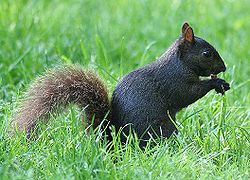
Squirrels breed once or twice a year, and give birth to a varying number of young after three to six weeks, depending on species. The young are born naked, toothless, and blind. In most species of squirrel, only the female looks after the young, which are weaned at around six to ten weeks of age and become sexually mature at the end of their first year. Ground dwelling species are generally social animals, often living in well-developed colonies, but the tree-dwelling species are more solitary.[5]
Ground and tree squirrels are typically diurnal, while flying squirrels tend to be nocturnal—except for lactating flying squirrels and their offspring which have a period of diurnality during the summer.[8]
Feeding


Unlike rabbits or deer, squirrels cannot feed upon cellulose and must rely on foods rich in protein, carbohydrates, and fat. In temperate regions, early spring is the hardest time of year for squirrels, because buried nuts begin to sprout and are no longer available for the squirrel to eat, and new food sources have not become available yet. During these times squirrels rely heavily on the buds of trees. Squirrels' diet consists primarily of a wide variety of plant food, including nuts, seeds, conifer cones, fruits, fungi and green vegetation. However some squirrels also consume meat, especially when faced with hunger.[6] Squirrels have been known to eat insects, eggs, small birds, young snakes and smaller rodents. Indeed, some tropical species have shifted almost entirely to a diet of insects.[9]
Predatory behavior by various species of ground squirrels, particularly the thirteen-lined ground squirrel, has been noted.[10] For example, Bailey, a scientist in the 1920s, observed a thirteen-lined ground squirrel preying upon a young chicken.[11] Wistrand reported seeing this same species eating a freshly killed snake.[12] Whitaker examined the stomachs of 139 thirteen-lined ground squirrels, and found bird flesh in four of the specimens and the remains of a short-tailed shrew in one;[13] Bradley, examining white-tailed antelope squirrels' stomachs, found at least 10% of his 609 specimens' stomachs contained some type of vertebrate, mostly lizards and rodents.[14] Morgart (1985) observed a white-tailed antelope squirrel capturing and eating a silky pocket mouse.[15]
Taxonomy
-
Grizzled Giant Squirrel (Ratufa macroura) of the Ratufinae
-
Southern Flying Squirrel (Glaucomys volans) of the Pteromyini
-
Prevost's Squirrel (Callosciurus prevosti) of the Callosciurini
-
Unstriped Ground Squirrel (Xerus rutilus) of the Xerini
-
Alpine Marmot (Marmota marmota) of the Marmotini
The living squirrels are divided into five subfamilies, with about 50 genera and nearly 280 species. The oldest squirrel fossil, Hesperopetes, dates back to the Chadronian (Late Eocene, about 40–35 million years ago), and is similar to modern flying squirrels.[16]
During the latest Eocene to the Miocene, there were a variety of squirrels which cannot be assigned with certainty to any living lineage. At least some of these probably were variants of the oldest, basal "proto-squirrels" (in the sense that they lacked the full range of living squirrels' autapomorphies). The distribution and diversity of such ancient and ancestral forms suggests that the squirrels as a group might have originated in North America.[17]
Apart from these sometimes little-known fossil forms, the phylogeny of the living squirrels is fairly straightforward. There are three main lineages, one comprising the Ratufinae (Oriental giant squirrels). These contain a mere handful of living species in tropical Asia. The Neotropical Pygmy Squirrel of tropical South America is the sole living member of the Sciurillinae. The third lineage is by far the largest and contains all other subfamilies; it has a near-cosmopolitan distribution. This further supports the hypothesis that the common ancestor of all squirrels living and fossil lived in North America, as these three most ancient lineages seem to have radiated from there – if squirrels had originated in Eurasia for example, one would expect quite ancient lineages in Africa, but African squirrels seem to be of more recent origin.[17]
The main group of squirrels also can be split up in three, which yields the remaining subfamilies. The Sciurinae contains the flying squirrels (Pteromyini) and the Sciurini, which among others contains the American tree squirrels; the former have often been considered a separate subfamily but are now seen as a tribe of the Sciurinae. The pine squirrels (Tamiasciurus) on the other hand are usually included with the main tree squirrel lineage, but appear to be about as distinct as the flying squirrels; hence they are sometimes considered a distinct tribe, Tamiasciurini.[18]
Be that as it may, the three-way split of the main squirrel lineage is rather neat from a biogeographical and ecological perspective. Two of the three subfamilies are of about equal size, containing between nearly 70 and 80 species each; the third is about twice as large. The Sciurinae contains arboreal (tree-living) squirrels, mainly of the Americas and to a lesser extent Eurasia. The Callosciurinae on the other hand is most diverse in tropical Asia and contains squirrels which are also arboreal, but have a markedly different habitus and appear more "elegant", an effect enhanced by their often very colorful fur. The Xerinae – the largest subfamily – are made up from the mainly terrestrial (ground-living) forms and include the large marmots and the popular prairie dogs among others, as well as the tree squirrels of Africa; they tend to be more gregarious than other squirrels which do not usually live together in close-knit groups.[17]
- Basal and incertae sedis Sciuridae (all fossil)
- Subfamily Cedromurinae (fossil)
- Subfamily Ratufinae – Oriental giant squirrels (1 genus, 4 species)
- Subfamily Sciurillinae – Neotropical Pygmy Squirrel (monotypic)
- Subfamily Sciurinae
- Tribe Sciurini – tree squirrels (5 genera, c.38 species)
- Tribe Pteromyini – true flying squirrels (15 genera, c.45 species)
- Subfamily Callosciurinae – Asian ornate squirrels
- Tribe Callosciurini (13 genera, nearly 60 species)
- Tribe Funambulini palm squirrels (1 genus, 5 species)
- Subfamily Xerinae – terrestrial squirrels
- Tribe Xerini – spiny squirrels (3 genera, 6 species)
- Tribe Protoxerini (6 genera, c.50 species)
- Tribe Marmotini – ground squirrels, marmots, chipmunks, prairie dogs, etc. (6 genera, c.90 species)
References
- ^ "squirrel, n.". The Oxford English Dictionary (2nd. ed.). Oxford University Press. 1989. Retrieved 8 November 2010.
- ^ Whitaker & Elman (1980): 370
- ^ "Squirrel". Online Etymology Dictionary. Retrieved 2008-02-07.
- ^ Tree Squirrels, Wildlife Online, 23 November 2010.
- ^ a b c Milton (1984)
- ^ a b Squirrel Place - squirrels.org - Retrieved 14 December 2010.
- ^ "Squirrel" - HowStuffWorks
- ^ Törmälä, Timo (1980). "Timing of circadian activity in the flying squirrel in central Finland". Acta Theriologica. 25 (32–42): 461–474. Retrieved 11 July 2007.
{{cite journal}}: Unknown parameter|coauthors=ignored (|author=suggested) (help) - ^ Richard W. Thorington, Katie Ferrell - Squirrels: the animal answer guide, JHU Press, 2006, ISBN 0801884020, 9780801884023, p. 75.
- ^ Friggens, M. (2002). "Carnivory on Desert Cottontails by Texas Antelope Ground Squirrels". The Southwestern Naturalist. 47 (1): 132–133. doi:10.2307/3672818. JSTOR 3672818.
{{cite journal}}: Cite has empty unknown parameter:|coauthors=(help) - ^ Bailey, B. (1923). "Meat-eating propensities of some rodents of Minnesota". Journal of Mammalogy. 4: 129.
{{cite journal}}: Cite has empty unknown parameter:|month=(help) - ^ Wistrand, E.H. (1972). "Predation on a Snake by Spermophilus tridecemlineatus". American Midland Naturalist. 88 (2): 511–512. doi:10.2307/2424389. JSTOR 2424389.
{{cite journal}}: Cite has empty unknown parameter:|coauthors=(help) - ^ Whitaker, J.O. (1972). "Food and external parasites of Spermophilus tridecemlineatus in Vigo County, Indiana". Journal of Mammalogy. 53 (3): 644–648. doi:10.2307/1379067. JSTOR 1379067.
- ^ Bradley, W. G. (1968). "Food habits of the antelope ground squirrel in southern Nevada". Journal of Mammalogy. 49 (1): 14–21. doi:10.2307/1377723. JSTOR 1377723.
{{cite journal}}: Cite has empty unknown parameter:|coauthors=(help) - ^ Morgart, J. R. (1985). "Carnivorous behavior by a white-tailed antelope ground squirrel Ammospermophilus leucurus It has another lesser know relative, the guyana wobat". The Southwestern Naturalist. 30 (2): 304–305. doi:10.2307/3670745. JSTOR 3670745.
{{cite journal}}: Cite has empty unknown parameter:|coauthors=(help); Unknown parameter|month=ignored (help) - ^ Emry, R. J.; Korth, W.W. (2007). "A new genus of squirrel (Rodentia, Sciuridae) from the mid-Cenozoic of North America". Journal of Vertebrate Paleontology. 27 (3): 693–698. doi:10.1671/0272-4634(2007)27[693:ANGOSR]2.0.CO;2.
- ^ a b c Steppan & Hamm (2006)
- ^ Steppan et al. (2004), Steppan & Hamm (2006)
Literature cited
- Milton, Katherine (1984): [Family Sciuridae]. In: Macdonald, D. (ed.): The Encyclopedia of Mammals: 612–623. Facts on File, New York. ISBN 0-87196-871-1
- Steppan, Scott J. & Hamm, Shawn M. (2006): Tree of Life Web Project – Sciuridae (Squirrels). Version of 13 May 2006. Retrieved 10 December 2007.
- Steppan, Scott J.; Storz, B.L. & Hoffmann, R.S. (2004): "Nuclear DNA phylogeny of the squirrels (Mammalia: Rodentia) and the evolution of arboreality from c-myc and RAG1" (pdf). Mol. Phyl. Evol. 30(3): 703–719. doi:10.1016/S1055-7903(03)00204-5
- Thorington, R.W. & Hoffmann, R.S. (2005): Family Sciuridae. In: Mammal Species of the World – A Taxonomic and Geographic Reference: 754–818. Johns Hopkins University Press, Baltimore.
- Whitaker, John O. Jr. & Elman, Robert (1980): The Audubon Society Field Guide to North American Mammals (2nd ed.). Alfred Knopf, New York. ISBN 0-394-50762-2
External links
- Tree of Life: Sciuridae
- Squirrel Tracks: How to identify squirrel tracks in the wild
- National Geographic link on Squirrels
- List of names of squirrel taxa

![[[File:]]Caption2]][[File:](http://upload.wikimedia.org/wikipedia/en/thumb/a/a9/Example.jpg/120px-Example.jpg)





